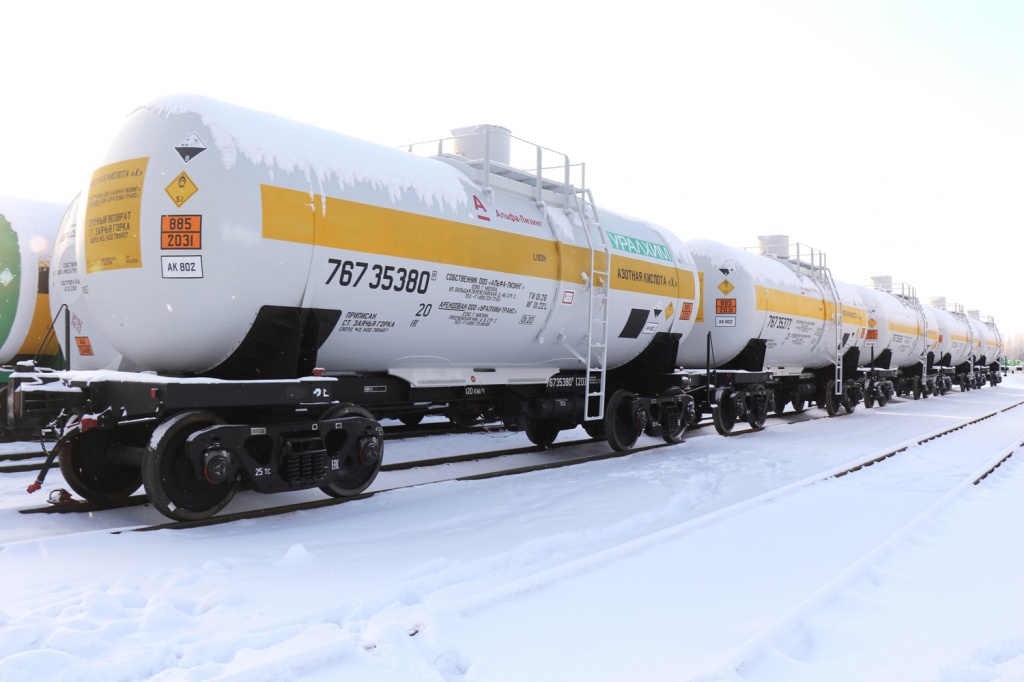United Wagon Company launches the supply of tank cars for URALCHEM to transport concentrated nitric acid
PJSC “Research and production corporation “United Wagon Company” (“UWC” or Holding) (MOEX: UWGN), being winner of the tender for the supply of 30 tank cars for concentrated nitric acid, shipped the first batch of cars to the United Chemical Company URALCHEM, one of the biggest producers of mineral fertilizers in the Russian Federation, the CIS and Eastern Europe. The contract will be fully executed till the end of February 2018.
Tank cars of the model 15-6901 with a tank volume of 54.78 m3 are equipped with a bogie having increased axle load of 25 tf which ensures effective use of the 75 ton load capacity; this increases car loading by a third compared to tank cars on traditional bogies.
When developing a fundamentally new tank car in terms of its specifications, quality and technologies, UWC acted as an integrator in the research and development effort of several companies from different sectors. As a result, the Russian market received an unrivaled new generation model of tank cars for concentrated nitric acid transportation.
All-Union Research and Development Centre for Transportation Technology was the developer of the new product for Holding whereas the TikhvinChemMash plant served as the manufacturer of rolling stock (both companies are parts of UWC). Arconik SMZ, the biggest Russian manufacturer of high-tech aluminum semi-finished products, became the supplier of corrosion-resistant aluminum plates whereas Sespel, the Cheboksary-based leading manufacturer of specialized machinery, took charge of the tank welding works. Alfa Leasing, a leading leasing company, financed the car acquisition deal.
As concentrated nitric acid is highly corrosive and toxic, the tank design involved freight-inert aluminum. The aluminum plates developed by Arconik SMZ experts specifically for this project have a broad range of mechanical and corrosion-resistant properties exceeding the requirements of the GOST standards. With leak-proof tanks and drainage systems, the freight is totally insulated from personnel and the environment. No-touch radar level meters ensure accurate metering of the freight volume in a wide temperature and pressure range even in a highly polluted and chemically aggressive environment.
The tank car’s service life is 40 years, compared to 20 years of the currently used tanks, with the run between depot repairs reaching 800 thou km (or 8 years), as compared to 210 thou km (or 2 years) for cars on traditional bogies.
The current Russian tank car fleet for carrying concentrated nitric acid amounts to ca. 200 units whose average age is 32 years. Until 2022, up to 80% of the fleet will have been decommissioned.
Maksim Smirnov, President of Arconik Russia, says: “We are proud that UWC sought the services of Arconik SMZ in developing a specialized solution to create new tank cars. This is our second joint project following the grain hopper car with enhanced performance that was certified last year. As part of the new order, we upgraded equipment and fine-tuned the technology of aluminum plate production in accordance with the client’s technical specifications. Aluminum has a good outlook for application in railway transport, and we are ready to provide wagon companies with improved products so as to create a fleet of innovative cars.”
Vladimir Bakshaev, Director of Sespel in Cheboksary, comments: “While manufacturing this tank our plant used the best welding technology for aluminum and its alloys: friction stir welding. Along with other technologies, it provided for high operational performance of the metal and helped us manufacture top-quality tanks in no time.”
Kirill Kyakk, CEO of All-Union Research and Development Centre for Transportation Technology (part of UWC), added: “Tank cars ensure the transportation of concentrated nitric acid during the technological cycle; accordingly, decommissioning old tanks is fraught with the halt of chemical production. Despite the small amount of such cars and the narrow market segment, the importance of these services cannot be overestimated. Last time the tank car with an aluminum tank was designed in 1963 and manufactured in the late 1980s. Since then rail transport and industrial safety requirements have changed significantly, and so did technologies. This project was a challenging one. At the design stage we considered not only the high performance characteristics and the level of hazardous freight insulation during transportation, but also the high economic efficiency of the tank car. In addition to the design works, we performed comprehensive testing of the new tank material and welded joints. As a result, a tank car with radically improved performance has been developed, certified and put into mass production.”
Vsevolod Kovshov, Director of URALCHEM-TRANS, said: “Our Company never stops working on its own car fleet renewal to make the delivery of our products more efficient and reliable. We prioritize the latest Russian developments: innovative cars with improved performance characteristics. UWC is one of our main partners in rolling stock procurement. The innovative tank model for concentrated nitric acid transportation was developed with due regard for the needs of our technical services, meeting the strictest safety requirements. The commission of a highly specialized tank car fleet will guarantee stable supplies of this product.”

All news

